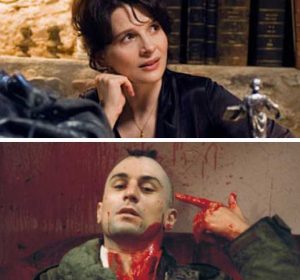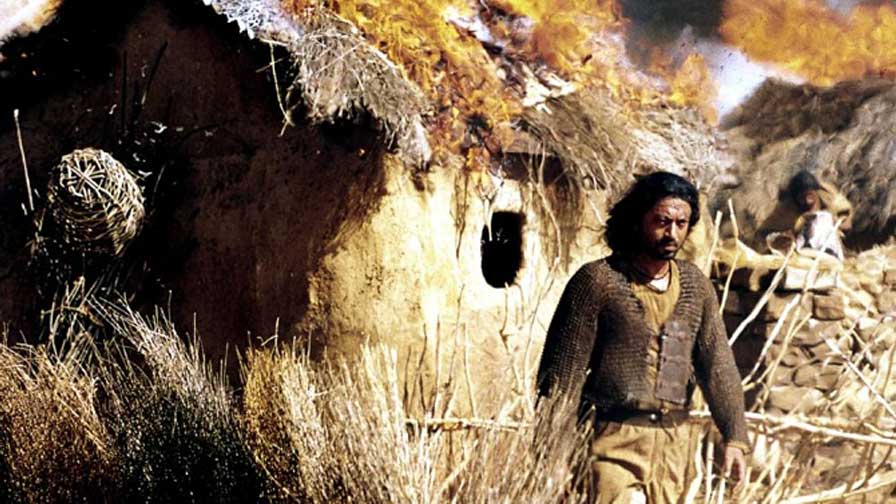‘I would never say such an unfeeling, rude thing such as that all actors are cattle. What I probably said was that all actors should be treated like cattle.’ actor
-Alfred Hitchcock, on the Dick Cavett show
‘Most enjoyable screen performances have been produced by nothing more than a typage, and it is commonplace to see dogs, babies, and rank amateurs who seem as interesting as trained thespians.’
-James Naremore, from Acting in the Cinema
With these two conscious teasing statements, I would like to begin my discourse on Irrfan Khan’s artistic persona, which is a supreme example of creating an actor’s definitive mark in this chaotic business of filmmaking. Quite self-consciously, I have quoted two sentences that are used to undermine, if not humiliate, an actor’s role in a film-text. Although James Naremore’s statement should not be judged by its face value, Hitchcock’s infamous words are out and out scandalous given the fact of his repeated dependency on great actor-stars, from Ingrid Bergman to James Stewart. Rather than judging these statements and starting a war of opposing opinions, I want to argue about a specific type of cinematic form that allows Hitchcock the right to make a seemingly crass statement. Furthermore, needless to say, cinema as a medium is highly different from an actor-oriented medium such as theatre, so my propositions and arguments will be centred on the questions related to cinematic medium and film form; no discussion on the art of film-acting can bypass either of these. The making of Irrfan’s gradually important persona is highly related to the forms of films in which he acted.
Before moving to any particular discussion on Irrfan’s own oeuvre, I want to discuss a few things about film acting in general. As I have mentioned earlier, it is quite well known that acting in cinema depends directly on many things that are absolutely uncontrollable for an actor. A slight change of light direction in a frame can create a major change of overall emotional or intellectual effect of a particular scene. The same is true for shot scale—an extreme long shot literally reduces an actor’s artistry into the overwhelming landscape and other components of the mise-en-scène. [highlight background=”#f79126″ color=”#ffffff”]Editing, of all things, can create a range of nuances even without an actor’s awareness[/highlight]—take, for instance, Kuleshov’s famous experiment with a single static face with three different elements that can create three different emotions out of the single expressive face. An actor’s work in a film is by nature fragmentary, and in no circumstances can they be fully aware of what the ‘meaning’ of their little gestures carry to the audience. Between the shooting of raw footage and the final output on the big screen, innumerable works are produced in which acting resides in one of the preliminary stages of the process. Here, an example of the famous scene from Casablanca (1942) can be illustrative. ‘It is rumoured that during the making of Casablanca, director Michael Curtiz positioned Bogart in close-up, telling him to look offscreen, to his left and nod. Bogart did so, having no idea what the action was supposed to signify. Later, when Bogart saw the completed picture, he realized his nod has been a turning point for the character he was playing: Rick’s signal to the band in the Café Americain to strike up the Marseillaise.’[1]

Cinema, at least in its mainstream expressive form, does not create space for an actor —a space that is dedicated and controlled by an actor’s own presence. Of course, the question of stardom arises here quite effectively: mainstream cinema does create space for stars to flourish. Like stock footages, the star system creates stock gestures and behavioural patterns that get repeated in film after film and thus creates a persona that is beyond the control of a particular film-text. We can discuss about Humphrey Bogart or [highlight background=”#f79126″ color=”#ffffff”]Ingrid Bergman’s famous smile or Shahrukh Khan’s stretched hands[/highlight], which are comparable to the iconography of a generic imagination—like the mountain valleys of the Westerns or the dimly-lighted cityscapes of the Film-Noirs. These specific iconographies are an important part of cinematic imagination, especially when we concentrate on stardom and its relation to audiences. Many of us love the Westerns for their expanded landscapes and wide-angle shots, and many of us love Ingrid Bergman for her beautiful, subtle smile—both are signatures.
But stardom is not necessarily depended wholly on acting. Although stars can surpass the oppressive cinematic apparatus by their repetitive use of same gestures, seldom can they control the definitive ‘meaning’ of their actions. As I have proposed earlier, this is related to the question of both the cinematic medium and film form. In cases where the cinematic medium is not friendly to the actors, I would like to know if there exists a film-form that, within the limitations of the medium, can create more space for actors that is not related to the question of stardom. In other words, I want to find if there is a possibility of film form that is dependent on the actor’s performances and which in turn can be dominated by their presence. And of course, the major question remains—is it possible that an actor, who is not necessarily a star, can wield command over the film form and compel the eyes of the spectator towards their performance? Is it possible for an actor to do that, even passively?
It can be said that with The Warrior (2001), Irrfan Khan marked his presence as a lead performer in cinema. Stylistically, the film locates itself in the arena of international art-house cinema, where the presence of actors is historically more important than the typical mainstream films. If classical Hollywood cinema (and its later mainstream formal manifestations) tend to limit actors’ performances with a systematic film form (dominated by editing), art cinema, on the other hand, tends to rely more on mise-en-scène and long takes. Irrfan did complete justice to this demand—starting from extreme close-ups of his expressive eyes to close-ups of his face in long, meditative takes. Nasiruddin Shah, albeit modestly, noted the rare quality of Irrfan’s performance in The Warrior, the kind of which, he claims, he himself hadn’t mastered at that young age.[2] Irrfan had managed to capture both the ruthless and helpless quality of the warrior with a fine touch of authenticity that he henceforth maintained. Standing firmly in the realm of realism, his acting matured from Maqbool (2003) and Road to Ladakh (2004) to The Namesake (2006). Still, he did not limit himself to a particular style of acting—as proven in his performances in Life in a … Metro (2007), Haider (2014) and Puzzle(2018). In these particular films, his performances are slightly stylized in order to be in sync with specific film forms. Irrfan’s capability to produce the same skill in altogether different styles of acting demonstrates his rare quality as an actor. Irrfan was as competent in the role of an apparently simple stranger in Road to Ladakh as the highly enigmatic Roohdaar in Haider. Another significant aspect is his casting as the rebel common man in the social thriller Madaari (2016); his common-man brand persona is reminiscent of Nasiruddin Shah in A Wednesday (2008).
But I do not want to summarize Irrfan’s oeuvre here. I have some specific questions in mind that I have already stated earlier. Almost all the films mentioned in the above paragraph are illustrative of basic questions of acting in the cinematic medium discussed earlier. We do not know the authorship of any of his subtle gestures; we do not know if they belong to Irrfan or the respective film directors. I have already stated that it is almost impossible to separate acting from the other elements of film—actors, at least in wholesome entertainers, do not have that much space. But I have also raised a few questions about a different film form, and here, André Bazin’s ideas will be highly important for us.
We remember Bazin for his proposition of a theory of realism in cinema that is different from the standard classical Hollywood realism. Bazin was in favour of a cinematic form in which the scenes had a documentary-like realistic look. He was against the fragmenting of shots and the incorporation of artificial meaning through editing. He vigorously opposed montage where the ‘meaning’ depends on the joining or collision of two images; where meaning is not there in either of the images. He called it trickery or deceiving. Long takes, which can meditate in front of reality and are dedicated to the materials being shown, were important to him.

Although Bazin did not incorporate the ideas of actors within this theoretical realm, we can extend his argument and bring in the idea of a cinematic form that, in order to meditate and capture the reality, by default meditates to the actor’s performances. When ‘Bazanian’ realism is opposed to the oppressive cinematic apparatus that disallows documentary-like reality to flourish with its own dignity, by default we can argue that with this cinematic form an actor’s performances becomes more important and meaningful in itself than the imposition of meaning chiefly through editing. Bazin praised the short fantasy film The Red Balloon precisely for this reason—it did not use the trickery of editing; the film allowed a balloon to follow a child in long takes and ‘show’ the reality, instead of suggesting a feel of reality by the use of cuts. Bazin wrote about this film: ‘Ballon Rouge is a pure creation of the mind, but the important thing about it is that this story owes everything to the cinema precisely because, essentially, it owes nothing.’[3] Here, he praised the relative absence of the cinematic apparatus, that is, editing, and championed a different idea of ‘cinematic,’ which is true and authentic to reality (in our argument, to actors) itself.
I want to argue that, in some cases, a cinematic form is possible that can create relative spaces for actors to perform, and that this creation of the space is tangentially related to the performer. And sometimes, it is possible for an actor to command the cinematic form for creating spaces for their performance. Here, the focus of the apparatus is to look at the performers (at reality; as Bazin said) and let the situation unfold through their performance (without resorting to the star’s iconographies). Irrfan Khan is a rare performer who did this in some of his films, one of the supreme examples of which is The Lunchbox (2013). Although it is true that the director’s intentions are important for creating these spaces, it is equally important for an actor to have that rare quality that can compel directors to look at their performance and allow reality to be embodied through it.
It is important to note that Irrfan did an ‘anti-Bazanian’ film in the year prior to the shooting of The Lunchbox—Paan Sing Tomar (2012). Here, throughout the protagonist’s running sequences—it is the camera and the editor who run—the spectator does not get to see a long take that shows a running sequence in its entirety. Now, I am not criticising the film for doing this, of course—this is just a different paradigm of filmmaking; one where most of the mainstream cinema resides (for instance, superhero films would have been impossible without these trickeries). But it is important to take note of The Lunchbox, in which such trickeries was not resorted to. Irrfan had to embody the sad and lonely bachelor life of an elderly government employee. The nuances of his character was not shown through montage. Instead, the camera was focussed on him to create meaning. Although The Lunchbox is not a ‘Bazanian’ film in a direct sense—it does not employ the two notable features of this school of thinking, namely, the long take, and deep focus photography—the essence of Bazin’s theory is palpable here. The film is dedicated not to the style, but to the reality. And according to my argument, such is dependent solely on the actors; sans an excellence of ‘realistic’, ‘authentic’ performance by the main performers (Nimrat Kaur and Nawazuddin Siddiqui too deserve mention here along with Irrfan), it can never meditate on the reality.

Now we can understand that it was the question of cinematic form that allowed Hitchcock the right to pronounce such a savage remark—in Hitchcock’s idea of film form, the apparatus is more important that the reality/actors. We are talking about a liberated film form that is in a way dominated by the actors’ presence in order to capture the reality. Although a film-maker’s decisions about the paradigm of a particular film is primary, it still requires actors such as Robert De Niro and Juliette Binoche to envision films like Taxi Driver (1976) and Certified Copy (2010), respectively; in both cases, the characters were written specifically with the said respective actors in mind. Like them, Irrfan too succeeded in commanding a space for acting without resorting to star iconographies. I wouldn’t really know if the idea of an ‘auteur’ can encompass this crucial aspect of acting, but, for me, such a signature truly is the hallmark of a great actor.
[divider top=”yes” style=”default” divider_color=”#999999″ link_color=”#999999″ size=”2″ margin=”0″]
[1] Naremore, James. Acting in the Cinema.
[2] Shah, Naseeruddin. Indian Express. May 3, 2020. ‘Irrfan’s legacy is like a constellation of stars for every actor to take inspiration from’. Retrieved: May 13, 2020.
[3] Bazin, André, What is Cinema. V-1, pp 46.






Leave a Reply
You must be logged in to post a comment.